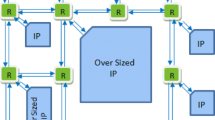Abstract
A power and latency efficient scheme for on-chip network communication is presented and its performance is analyzed. This new scheme is designed for a general architecture with a buffered/bufferless router (BR/BLR), which eliminates buffers in the majority of routers to achieve power efficiency while keeping buffers in a few routers to facilitate various desirable services and to reduce latency. Extensive simulation shows that the proposed scheme performs better than purely bufferless as well as buffered approach under different synthetic traffic patterns.
Similar content being viewed by others
References
Dally WJ, Towles B (2001) Route packets, not wires: on-chip interconnection networks. In: Proceeding of design automation conference, pp 684–689
Benini L, Micheli GD (2002) Networks on chips: a new SoC paradigm. Computer 35:70–78
Marculescu R, Ogras UY, Peh L-S, Jerger NE, Hoskote Y (2009) Outstanding research problems in NoC design system microarchitecture and circuit perspectives. IEEE Trans Comput-Aided Des Integr Circuits Syst 28:3–21
Meincke T et al (1999) Globally asynchronous locally synchronous architecture for large high-performance ASICs. In: Proceeding of international symposium on circuits and systems, vol 2, pp 512–515
Shang L, Peh L-S, Jha NK (2003) Dynamic voltage scaling with links for power optimization of interconnection networks. In: Proceeding of international symposium on high performance computer architecture, pp 91–102
Balfour J, Dally WJ (2006) Design tradeoffs for tiled CMP on-chip networks. In: Proceeding of international conference on supercomputing, pp 187–198
Kodi AK, Sarathy A, Louri A (2008) iDEAL: inter-router dual-function energy and area-efficient links for network-on-chip (NoC) architecture. In: Proceeding of international symposium on computer architecture, pp 241–250
Kim J (2009) Low-cost router microarchitecture for on-chip networks. In: Proceeding of IEEE/ACM international symposium on microarchitecture, pp 255–266
Moscibroda T, Mutlu O (2009) A case for bufferless routing in on-chip networks. In: Proceeding of international symposium on computer architecture, pp 196–207
Vangal SR et al (2008) An 80-tile sub-100-W TeraFLOPS processor in 65-nm CMOS. IEEE J Solid-State Circuits 43:29–41
Gomez C, Gomez ME, Lopez P, Duato J (2008) Reducing packet dropping in a bufferless NoC. In: Proceeding of international Euro-Par conference on parallel processing, pp 899–909
Hayenga M, Jerger NE, Lipasti M (2009) SCARAB: a single cycle adaptive routing and bufferless network. In: MICRO’09, pp 244–254
Bouhraoua A, Elrabaa MES (2007) An efficient network-on-chip architecture based on the fat-tree (FT) topology. Arab J Sci Eng 32:13–26
Gratz P, Kim C, McDonald R, Keckler SW, Burger D (2006) Implementation and evaluation of on-chip network architectures. In: Proceeding of international conference on computer design, pp 477–484
Hu J, Marculescu R (2004) Application-specific buffer space allocation for networks-on-chip router design. In: IEEE/ACM international conference on computer-aided design, pp 354–361
Michelogiannakis G, Sanchez D, Dally WJ, Kozyrakis C (2010) Evaluating bufferless flow control for on-chip networks. In: Proceeding of IEEE/ACM international symposium on networks-on-chip, pp 9–16
Ni LM, Mckinley PK (1993) A survey of wormhole routing techniques in direct networks. Computer 26:62–76
Lu Z (2005) Using wormhole switching for networks on chip: feasibility analysis and micro-architecture adaptation. Licentiate thesis, Royal Institute of Technology
Lu Z, Zhong M, Jantsch A (2006) Evaluation of on-chip networks using deflection routing. In: Proceeding of ACM Great Lakes symposium on VLSI, pp 296–301
Dally WJ, Towles BP (2004) Principles and practices of interconnection networks. Morgan Kaufmann, San Mateo
Ogras UY, Marculescu R, Lee HG, Chang N (2006) Communication architecture optimization: making the shortest path shorter in regular networks-on-chip. In: Proceeding of the design automation and test in Europe, pp 712–717
http://nocs.stanford.edu/cgi-bin/trac.cgi/wiki/Resources/BookSim
Author information
Authors and Affiliations
Corresponding author
Rights and permissions
About this article
Cite this article
Lin, J., Lin, X. Power and latency efficient mechanism: a seamless bridge between buffered and bufferless routing in on-chip network. J Supercomput 61, 1048–1067 (2012). https://doi.org/10.1007/s11227-011-0676-3
Published:
Issue Date:
DOI: https://doi.org/10.1007/s11227-011-0676-3




